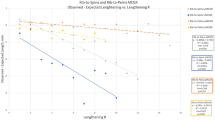Abstract
Study Design
Retrospective multicenter, case-control study.
Objective
To compare the risks of rod breakage and anchor complications between distraction-based growing rods with proximal spine versus rib anchors.
Summary of Background Data
Rod breakage is a known complication of distraction-based growing rod instrumentation.
Methods
A total of 176 patients met inclusion criteria: minimum 2-year follow-up, younger than age 9 years at index surgery, non—Vertical Expandable Prosthetic Titanium Rib distraction-based growing rods, and known anchor locations. Mean follow-up was 56 months (range, 24—152 months). Survival analyses using Cox proportional hazards model (accounting for varying lengths of follow-up) of rod breakage, anchor complications, preoperative Cobb angle, number of growing rods, age, and number of levels instrumented were performed using a significance level of p <.05.
Results
Thirty-four patients had rib-anchored growing rods and 142 had spine-anchored growing rods. This analysis found that proximal rib-anchored growing rods have a 23% risk of lifetime rod breakage compared with spine-anchored growing rods (6% vs. 29%) (p =.041) without a significant increase in risk of anchor complications (38% vs. 33%) (p =.117). The number of implanted rods (p =.839), age (p =.649), and number of instrumented levels (p =.447) were not statistically significant regarding rod breakage risk, although higher preoperative Cobb angles were significant (p =.014).
Conclusions
Preoperative Cobb angle appears to be the most influential factor in determining whether growing rods break (p =.014). Univariate analysis found that rib anchors were associated with less than one-fourth the risk of rod breakage than spine anchors (p =.04) but multivariate analysis found no significant association between anchors and rod breakage (p =.07). This trend suggests that rib-anchored growing rod systems may be associated with less rod breakage because the system is less rigid as a result of some “slop” at the hook—rib interface, as well as the normal motion of the costovertebral joint.
Similar content being viewed by others
References
Moe JH, Kharrat K, Winter RB, Cummine JL. Harrington instrumentation without fusion plus external orthotic support for the treatment of difficult curvature problems in young children. Clin Orthop Relat Res 1984;185:35–45.
Yang JS, Sponseller PD, Thompson GH, et al. Growing rod fractures: risk factors and opportunities for prevention. Spine (Phila Pa 1976) 2011;36:1639–44.
Klemme WR, Denis F, Winter RB, et al. Spinal instrumentation without fusion for progressive scoliosis in young children. J Pediatr Orthop 1997;17:734–42.
Mineiro J, Weinstein SL. Subcutaneous rodding for progressive spinal curvatures: early results. J Pediatr Orthop 2002;22:290–5.
Bess S, Akbarnia BA, Thompson GH, et al. Complications of growing-rod treatment for early-onset scoliosis: analysis of one hundred and forty patients. J Bone Joint Surg Am 2010;92:2533–43.
Watanabe K, Uno K, Suzuki T, et al. Risk factors for complications associated with growing-rod surgery for early-onset scoliosis. Spine (Phila Pa 1976) 2013;38:E464–8.
Author information
Authors and Affiliations
Consortia
Corresponding author
Additional information
Author disclosures: KTY (none); DLS (grants from POSNA, Scoliosis Research Society; personal fees from Biomet, Medtronic, Stryker, Wolters Kluwer Health—Lippincott Williams & Wilkins; non-financial support from Growing Spine Study Group, Scoliosis Research Society, Growing Spine Foundation Medtronic Strategic Advisory Board; personal fees from expert testimony; other from Medtronic, Stryker, Bio-met, Medtronic, outside the submitted work; patent issued by Medtronic); SM (none); KSM (none); MY (personal fees from DePuy Synthes, Stryker, outside the submitted work); CJ (other from Medtronic, outside the submitted work); GT (personal fees as Co-Editor, Journal of Pediatric Orthopaedics, Lippincott, Williams and Wilkins; personal fees from Medical Advisory Board, Shriner’s Hospital for Children; non-financial support as President/CEO SICOT Foundation; non-financial support from OrthoPediatrics; personal fees from Ortho-Pediatrics, non-financial support from SpineForm, outside the submitted work; son works for nuVasive Medical Technologies); PS (other from Journal of Bone and Joint Surgery, Oakstone Medical, Globus Medical, DePuy Synthes Spine, outside the submitted work); BA (personal fees from Kspine, K2M, Ellipse Technologies; grants and personal fees from Nuvasive, OREF, DePuy Spine, outside the submitted work); MV (non-financial support from AAP Section on Orthopaedics; personal fees, non-financial support and other from CSSG; personal fees from Stryker, Biomet; grants from AOSpine, CSSG, OREF, Scoliosis Research Society; grants and other from POSNA, grants and non-financial support from Medtronic, grants from OMeGA, other from Broadwater [Biomet, Synthes, Stryker, Medtronic, K2]; other from FoxPSDSG, outside the submitted work).
This work was supported by a research grant provided by the Growing Spine Foundation.
Rights and permissions
About this article
Cite this article
Yamaguchi, K.T., Skaggs, D.L., Mansour, S. et al. Are Rib Versus Spine Anchors Protective Against Breakage of Growing Rods?. Spine Deform 2, 489–492 (2014). https://doi.org/10.1016/j.jspd.2014.08.007
Received:
Revised:
Accepted:
Published:
Issue Date:
DOI: https://doi.org/10.1016/j.jspd.2014.08.007




